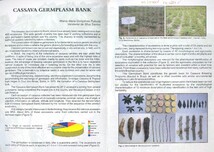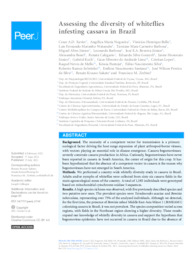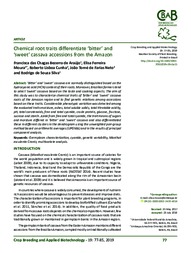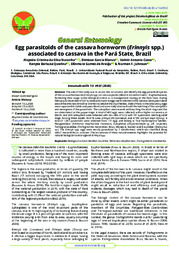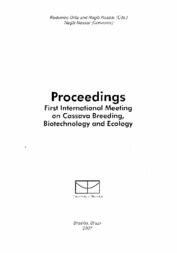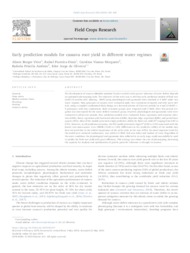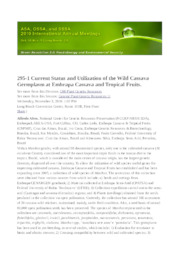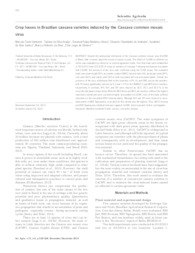Search Publications
Filter by:
| Author(s): FUKUDA, W. M. G.; SANTOS, V. da S. The cassava plant is native to Brazil, where have already been catalogued more than 4000 accessions. This wide genetic diversity has been kept in working collections and in active germplasm banks spre... ... |
| Author(s): XAVIER, C. A. D.; NOGUEIRA, A. M.; BELLO, V. H.; WATANABE, L. F. M.; BARBOSA, T. M. C.; ALVES JÚNIOR, M.; BARBOSA, L.; BESERRA-JÚNIOR, J. E. A.; BOARI, A. de J.; CALEGARIO, R.; GORAYEB, E. S.; HONORATO JÚNIOR, J.; KOCH, G.; LIMA, G. S. de A.; LOPES, C.; MELLO, R. N. de; PANTOJA, K.; SILVA, F. N.; RAMOS SOBRINHO, R.; SANTANA, E. N.; SILVA, J. W. P. da; KRAUSE-SAKATE, R.; ZERBINI, F. M. Background. The necessity of a competent vector for transmission is a primary ecological factor driving the host range expansion of plant arthropod-borne viruses, with vectors playing an essential rol... ... |
| Author(s): ARAÚJO, F. das C. B. de; CUNHA, E. F. M.; CUNHA, R. L.; FARIAS NETO, J. T. de; SILVA, R. de S. 'Bitter' and 'sweet' cassava are normally distinguished based on the hydrocyanic acid (HCN) content of their roots. Moreover, Brazilian farmers tend to select 'sweet' cassava based on the taste and co... ... |
| Author(s): NORONHA, A. C. da S.; BLANCO, D. G. B.; COSTA, V. A.; SILVA, R. B. Q. da; ARAÚJO, D. G. de; JOHNSON, N. F. The aim of this study was to assess the occurrence and identify the egg-parasitoid species of the cassava hornworm (Erinnyis spp.) in cassava plants (Manihot esculenta Crantz - Euphorbiaceae), facilit... ... |
| Author(s): OLIVEIRA, E. J. de; OLIVEIRA, S. A. S. de; VILAS BOAS, S. A.; HOHENFELD, C. S.; SANTOS, V. da S. The cassava root rot disease (CRRD) severely affects productivity in several countries. The objective of this study was to estimate genetic parameters and to identify multiple resistance sources again... ... |
| Author(s): ALVES, R. M. V.; CAMPOS, A. C. M. G. de; ITO, D.; CARVALHO, J. L. V. de; OLIVEIRA, L. A. de; PACHECO, S. The purpose of this study was to survey information on the effect of the type of package and packaging system of the product to preserve the nutritional and sensorial quality of biofortified fried cas... ... |
| Author(s): VITOR, A. B.; DINIZ, R. P.; MORGANTE, C. V.; ANTONIO, R. P.; OLIVEIRA, E. J. de The development of cassava (Manihot esculenta Crantz) varieties with greater tolerance of water deficit depends on optimized phenotyping tools. The objective of this work was to develop early predicti... ... |
| Current status and utilization of the wild cassava germplasm at Embrapa Cassava and Tropical Fruits. Author(s): ALVES, A. A. C.; LEDO, C. A. da S.; COSTA, I. R. S.; MENDES, R.; CARVALHO, P.; SILVA, A. F. Within Manihot gender, with around 98 documented species, only one is the cultivated cassava (M. esculenta Crantz), considered one of the most important staple foods in the human diet in the tropics.... ... |
| Author(s): VENTURINI, M. T.; ARAÚJO, T. da S.; ABREU, E. F. M.; ANDRADE, E. C. de; SANTOS, V. da S.; SILVA, M. R. da; OLIVEIRA, E. J. de Despite the widespread distribution of the Cassava common mosaic virus (CsCMV) in Brazil, little is known about the losses it causes in yield. The effect of CsCMV on different varieties was evaluated... ... |
Observation
Some of Embrapa's publications are published as ePub files. To read them, use or download one of the following free software options to your computer or mobile device. Android: Google Play Books; IOS: iBooks; Windows and Linux: Calibre.
Access other publications
Access the Agricultural Research Database (BDPA) to consult Embrapa's full library collection and records.
Visit Embrapa Bookstore to purchase books and other publications sold by Embrapa.

